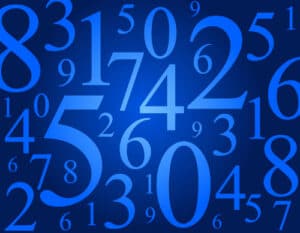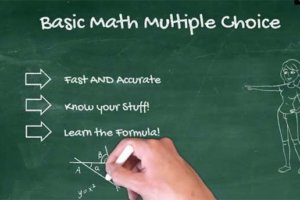Number Series Practice and Tutorials
- Posted by Brian Stocker MA
- Date May 12, 2014
- Comments 7 comments

Number series are where a series of numbers are given and students must calculate either the missing numbers or the number that follows. Number series questions are a type of logic or problem solving questions
Standardized Tests such as the Ontario Police, Canadian Armed Forces Entrance Test Canada Border Services GardaWorld
What’s on this Page
Number Series Examples
An example is:
Consider the following series: 26, 21, , 11, 6. What is the missing number?
a. 27
b. 23
c. 16
d. 29
Looking carefully at the sequence, we can see right away that each number is 5 less than the previous number, so the missing number is 16.
We can re-write this sequence in mathematical notation as, a1, a2, a3,… an, where n is an integer and an is called its nth term. And we can write the sequence in the form of a formula, where an integer is substituted in the place of the variable in the formula and the terms are obtained.
For example, let us consider the sequence 5,10,15,20,…
- Here, an = 5n. The formula an = 5n.
- The nth term of a sequence can be found by plugging n in the explicit formula for the sequence. So for example if we wanted to find the 100thnumber in this sequence, we would substitute n=100 in the formula and get 500.
Types of Number Series problems
1. Simple addition or subtraction – each number in the sequence is obtained by adding a number to the previous number.
For example, 2, 5, 8, 11, 14
Each number in the sequence is obtained by adding 3 to the previous number, which we could write as, an+1 = an + 3.
2. Simple multiplication – each number in the sequence is obtained by multiplying the previous number by a whole number or fraction.
For example, 3, 9, 27, 81
Or,
20, 10, 5, 2.5
Each number in the first sequence is obtained by multiplying the previous number by 3, which we could write as, an+1 = an X 3.
In the second example, each number in the series is the previous number divided by 2, or multiplied by ½, or an+1 = an X 1/2.
3. Prime Numbers – each number in the sequence is a prime number.
For example,
23, , 31, 37
Answer: 29
4. Operations on the previous two numbers
For example,
8, 14, 22, 36, 58
Here the sequence is created by adding the previous 2 numbers.
5. Exponents
The number sequence is created by each number squared or cubed.
For example,
3, 9, 81, 6561, where each number is squared.
6. Combining Sequences
2, 7, 13, 20, 28, 37
Here the sequence starts with 2, and each element is added to another sequence starting with 5. So, 2 + 5 = 7, 7 + 6 = 13, 13 + 7 = 20 and so on.
A variation is a sequence with a repeating element. For example,
1, 2, 3, 5, 7, 9, 12, 15
Here the sequence is, for each n, +1, +1, +1, +2, +2, +2, +3, +3,
7. Fractions
For example,
16/4, 4/2, 2/2, ½, ?
Fractions are often meant to confuse. If fractions don`t have an obvious relationship, reduce them to lowest terms or to whole numbers. Reducing these to whole numbers, gives,
4, 2, 1, ½
Right away we can see the numbers are half the previous number, so the next in the series is ¼.
In this example, the answer is a fraction, however, you may have to reduce fractions to see the relation, and then convert back to get the answer in the correct form.
Strategy for Answering Number Series Questions
Here is a quick method that will help you answer number series.
For example:
2, 5, 6, 7, 8,
Step 1 – glance at the series quickly and see if you can spot the pattern right away. First look for obvious differences – 2X, 5X, 1/2, 1/4 etc.
Step 2 – Start analyzing. If you can’t find an obvious answer, get to work.
Take the different between the first 2 numbers and the different between the second 2 numbers.
2, (+3) 5, (+1) 6, (+1) 7, (+1) 8,
No clear pattern with a simple analysis. There is no addition,
subtraction, multiplication, division, fractional or exponent
relationship.
The relation must be a higher order or a second series.
Next look at the relation between the 1st number and the
2nd and the 1st and the 3rd. We see that,
1st + 3 = 5, 1st + 4 = 6. That’s it! The number 2 is added
to the sequence, 3, 4, 5, 6, so the next number will be 2 +
7 = 9.
Number Series Practice Questions
1. Consider the following series: 6, 12, 24, 48. What number should come next?
a. 48
b. 64
c. 60
d. 96
2. Consider the following series: 5, 6, 11, 17. What number should come next?
a. 28
b. 34
c. 36
d. 27
3. Consider the following series: 26, 21, …, 11, 6. What is the missing number?
a. 27
b. 23
c. 16
d. 29
4. Consider the following series:23, …, 31, 37. What is the missing number?
a. 19
b. 27
c. 29
d. 30
5. Consider the following series: 3, 6, 11, 18. What number should come next?
a. 30
b. 27
c. 22
d. 29
6. Consider the following series: 26, 24, 20, 14. What number should come next?
a. 6
b. 18
c. 12
d. 8
7. Consider the following series: 6, 8, 4, 10, 18, 22. What number should come next?
a. 34
b. 32
c. 24
d. 26
8. Consider the following series: L, O, R, …, X. What is the missing letter?
a. S
b. U
c. T
d. M
9. Consider the following series: X, Z, B, D. What letter should come next?
a. E
b. F
c. G
d. H
10. Consider the following series: 25, 33, 41, 49. What number should come next?
a. 51
b. 55
c. 59
d. 57
Answer Key
1. D
The numbers double each time.
2. A
Each number is the sum of the previous two numbers.
3. C
The numbers decrease by 5 each time.
4. C
The numbers are primes (divisible only by 1 and themselves).
5. B
The interval, beginning with 3, increases by 2 each time.
6. A
The interval, beginning with 2, increases by 2, and is subtracted each time.
7. B
Each number is the sum of the previous and the number 2 places to the
left.
8. B
There are two letters missing between each one, so U is next.
9. B
Miss a letter each time and ‘loop’ back, so F is next.
10. D
The numbers increase by 8.
Common Mistakes on Number Series Questions
Not identifying the pattern. The most common mistakes is not recognizing the pattern correctly. Carefully analyze the sequence looking for arithmetic, geometric, or other patterns.
Incorrectly applying the pattern. After correctly identifying the pattern, make sure you apply it correctly!
Not considering alternative patterns. Remember there may be several patterns, or what appear to be several patterns. Consider all possibilities and carefully before selecting the answer.
Why do Tests have Number Series Questions?
1. Assessment of Analytical Skills
Number series questions test your ability to recognize patterns, sequences, and logical progressions. These skills are crucial for problem-solving in many fields, including mathematics, science, and engineering.
2. Test of Mathematical Reasoning
Number Series questions require you to apply your knowledge of arithmetic and algebraic principles to solve problems. Basic math practice Algebra practice
3. Recognizing Patterns
General pattern recognition and flexible thinking are important skills. Graphic matching practice
4. Thinking Logically
Logical thinking and deductive reasoning are essential for many academic disciplines and professionals, as well as everyday life. Deducing the next number in a sequence based on a logical pattern is an important skill. Logic Practice questions
5. Speed and Accuracy
Standardized tests often have time constraints, and number series questions can evaluate how quickly and accurately a candidate can process and respond to numerical information. This aspect is crucial for many real-world tasks where time-efficient problem-solving is necessary. How to work with time limits on a test
Date Published: Monday, May 12th, 2014
Date Modified: Thursday, June 13th, 2024
You may also like

Basic Math Video Tutorials

How to Answer Basic Math Multiple Choice
How to Solve Linear Inequalities – Quick Review and Practice
Basic linear inequalities have one of the following forms: ax + b > 0 ax + b < 0 ax + b > 0 ax + b < 0 where a and b are some real numbers. Our solution to …

7 Comments
thank you (:
Are you open to explaining #7 a bit more? I am a bit confused by it. Thanks.
Here is the sequence 6, 8, 4, 10, 18, 22.
so – it is the sum of the number and the number 2 spaces back. Starting at 4 as we don’t know the number before 6, 6 + 4 = 10, then 8 + 10 = 18, and 22 + 10 = 32.
For number 4 I would say there is an alternate answer.
By assuming that the second number in the sequence is 27 (b) you can create a pattern in which the 3rd number is +8 bigger than the 1st, 4th is +10 bigger that the 2nd, and hypothetically the 5th number (43) is +12 bigger than the 3rd.
Just thought it was interesting.
Agreed, I was also looked at in a same way and got an answer 27. So if we assume the number pattern start with first number + 4 and then every sequence the number get increase by 1 then the pattern gets created, 23+4 = 27,
27+5 = 31,
31+6 = 37, so answer comes 27.
Also, the correct answer mentioned as 27 as prime number but there is another option which also a prime number that is 19.
Thank you a lot my friend … I ‘ve learned a lot here today.
It’s 2023. Thank you for this